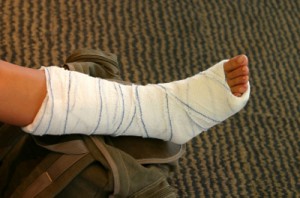 Broken bones and fractures are injuries that need immediate medical attention. Aside from the trauma of bones breaking or fracturing, there are several other symptoms that might manifest. First Aid and CPR courses will teach you what to do to help someone with a broken or fractured bone.
Broken bones and fractures are injuries that need immediate medical attention. Aside from the trauma of bones breaking or fracturing, there are several other symptoms that might manifest. First Aid and CPR courses will teach you what to do to help someone with a broken or fractured bone.
Steps in Administering First Aid for Broken or Fractured Bones
- One of the things that First Aid courses emphasize is to call 911 for severe injuries. Some Indications of a severe injury caused by broken or fractured bones are –
– Unconsciousness or a victim having no heartbeat and needing CPR
– Symptoms of shock in the victim (paleness, cold sweat, shortness of breath and/or disorientation)
– severe bleeding.
– limbs or joints that look deformed or positioned unusually
– pain that’s caused by slight movement or pressure
– bone has pierced the skin
– the injured limb is numb or has a bluish tinge
- Stop bleeding immediately. Gently apply direct pressure over the injury using a clean and sterile material over the injury but don’t apply directly over the broken or fractured bone. Don’t remove any object protruding from the skin as removing it might result in severe blood loss.
- Don’t move the injured area unless circulation is in danger of being cut off. Patients suffering from a fractured hip or pelvis must not be moved as well.
- Make a splint for the injured bone by gently tying it a board, stick, newspaper or any stiff object and padding it with clothing or anything soft. Make sure the splint is securely fastened on both sides of the injured bone but not directly on the break.
- Remove any jewelry a person with a broken or fractured arm, hand or wrist is wearing. Neglecting to do so immediately will make it harder to remove later on when the swelling begins.
- Put ice on the injured area to minimize swelling. However, never put ice directly on the skin. It should be wrapped in cloth or a plastic bag to contain the ice and to prevent frostbite.
- Check the patient’s blood circulation. Choose a spot past the injured area and firmly press down on the skin. It should turn pink seconds after you lift your fingertips; if it doesn’t, then blood isn’t circulating normally. Check the patient for skin that’s turning pale or blue, loss of pulse or any tingling or numbness of the skin.
- Stop shock from happening by making sure the patient is laying flat on his or her back, their feet are elevated by about 12” above the head and that the patient is covered with a blanket or coat. Skip this if the injured area is in the back, head or neck region.
- Alleviate the patient’s pain by giving painkillers. Be mindful that victims 21 years old and younger should just be given meds acetaminophen.
- Make sure that the injury is looked at and treated by qualified medical practitioner as soon as possible.
There are numerous situations where one might encounter fractures or broken bones. While injured bones can look grisly, it’s still important that we help out and administer first aid. There are a number of St Mark James programs that can give you clear and easy to follow instructions on how to treat injured bones.
